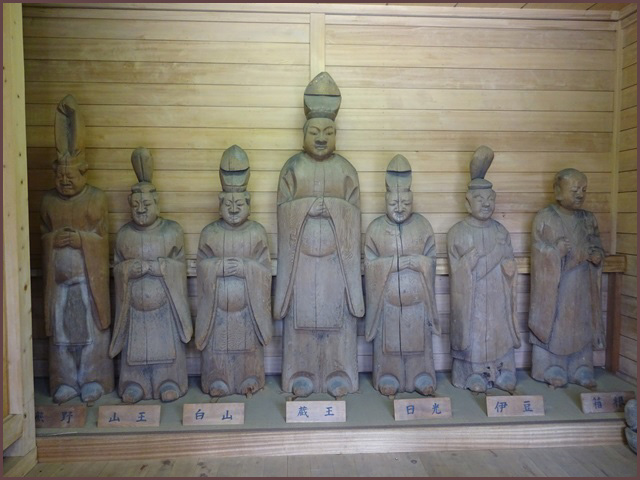::::::::::::::::::::::::::::::::::::::::::::::::::::::::::::::::::::::::::::::::::::::::::::::::::::::::::::::::::::::::::::::::::::::::::::::::::::::::::::::::::::::::::::::
Ryoosenji, Ryōsen-ji 霊山寺 Ryosen-Ji
大和國 登美山鼻高 霊山寺

3873 Nakamachi, Nara - 奈良県奈良市中町3879
- quote
Founded in the eighth century, the Hondō is a National Treasure and a number of other buildings and temple treasures have been designated Important Cultural Properties.
In the late seventh century Ono no Tobito erected a set of public baths on Mount Tomi 登美山 outside Nara and enshrined an image of Yakushi. In 734 Emperor Shōmu instructed Gyōki to erect a hall on the site, and two years later the Indian monk Bodhisena, noticing a resemblance to the Vulture Peak, founded the Ryōsen-ji.

Three storey pagoda 三重塔(重文) (1356), hinoki bark roof
The Hondō was rebuilt in 1283. Toyotomi Hideyoshi granted the temple lands valued at a hundred koku. In the Meiji period many of the monk's quarters were abandoned and over two hundred images were burned. Restored in 1940, the temple has been revived.
Jūrokusho Jinja (十六所神社) Jurokusho Jinja
is now an independent shrine, but before the Meiji period served Ryōsen-ji in a tutelary capacity. The Honden (1384) and subordinate Sumiyoshi Jinja Honden and Ryūō Jinja Honden (both 1386) have been designated Important Cultural Properties.
- source : wikipedia

. Gyoki Bosatsu 行基菩薩 and Bodhisena 菩提僊那 .
(668-749 AD) Gyōki - (704 - 760) Bodaisenna
..............................................................................................................................................
The great bell in the bell tower makes a sound reminding of the Buddhist Jodo Paradise. Visitors must ring it three times and listen to the reveberating sound of wisdom of the bell, considering life, death and re-birth and also peace in the world.
::::::::::::::::::::::::::::::::::::::::::::::::::::::::::::::::::::::::::::::::::::::::::::::::::::::::::::::::::::::::::::::::::::::::::::::::::::::::::::::::::::::::::::::
Yakushi Yudono 薬師湯殿 The Yakushi Bath Hall

In 672 Ono no Tobito 小野富人, son of the famous Ono no Imoko 小野妹子 and now also called 鼻高仙人 Biko Sennin, took refuge on Mount Tomi 登美山 and planted a garden full of herbs to put in the water. He then erected a set of public baths and enshrined an image of Yakushi Nyorai. Many people from the villages around came here to heal their diseases and take a rest. In 1982 the hall was rebuild in its present form and open to the public.
. . Yakushi Nyorai, the Buddha of Medicine 薬師如来 . .
. byooki heiyu 病気平癒 healing a disease .
. Ono no Imoko 小野妹子 .
::::::::::::::::::::::::::::::::::::::::::::::::::::::::::::::::::::::::::::::::::::::::::::::::::::::::::::::::::::::::::::::::::::::::::::::::::::::::::::::::::::::::::::::

The famous rose garden バラ庭園 - designed by the previous head priest in 1975 for visitors to relax and get refreshed and with the wish for peace in the world.
It relates to the circle of life. The first part considers the Mother-Child connection with red, light-colored roses. Up a few steps is a fountain, the symbol of the circle of birth and re-birth. In the back is a terasse to enjoy some tea.
Best visited from mid-May till mid-June or mid-October till mid-November
バラ園に詣でるなんて旬の技
making a pilgrimage
to the rose garden -
treat of the season
Gabi Greve, July 2014
..............................................................................................................................................

CLICK for enlargement to read.
- Homepage of the temple
- source : www.ryosenji.jp
Godai Myo-O 五大明王尊像
(不動明王・大威徳明王・金剛薬叉明王・軍茶利明王・降三世明王)


source : www.taleofgenji.org
At the graveyard are 12 statues of the protector deities for each of the 12 zodiac animal and people born in that year. Fudo Myo-O is one of them.
. Fudō Myō-ō, Fudoo Myoo-Oo 不動明王 Fudo Myo-O
Acala Vidyârâja - Vidyaraja .
..............................................................................................................................................
A torii 鳥居は神門 entrance gate to a Shinto shrine, here for the Benzaiten 辯財天 sanctuary, 弁天堂 Benten-Do
Every spring on the 17th of April, a great fire ritual is held in front of the hall, to honor Fudo Myo-O, who is located in the sub-temple 東光院 Toko-In within the compound. Benten here is said to please Fudo Myo-O with this fire ritual.

. Benten, Benzaiten 弁天 弁財天 .
::::::::::::::::::::::::::::::::::::::::::::::::::::::::::::::::::::::::::::::::::::::::::::::::::::::::::::::::::::::::::::::::::::::::::::::::::::::::::::::::::::::::::::::
. Pilgrimages to Fudo Temples 不動明王巡礼
Fudo Myo-O Junrei - Fudo Pilgrims - INTRODUCTION .
. Japan - Shrines and Temples - ABC .
[ . BACK to DARUMA MUSEUM . TOP . ]
[ . BACK to WORLDKIGO . TOP . ]
::::::::::::::::::::::::::::::::::::::::::::::::::::::::::::::::::::::::::::::::::::::::::::::::::::::::::::::::::::::::::::::::::::::::::::::::::::::::::::::::::::::::::::::











